Hyundai Santa Fe (2018-2024) Review
Written by Lawrence Allan
Quick overview
Pros
- Versatile cabin with room for seven adults
- Loads of standard kit
- Can be had as a diesel, hybrid or plug-in hybrid
Cons
- Not as cheap as it once was
- Dash is very button-heavy
- Road tax will be costly on new diesels
Overall verdict on the Hyundai Santa Fe
"It isn't quite a budget large family SUV any more, but the Hyundai Santa Fe has plenty going for it including a roomier cabin than a Skoda Kodiaq, a huge equipment tally and a smooth, easy-going driving experience. Is that enough? Our 2022 Hyundai Santa Fe review will find out."
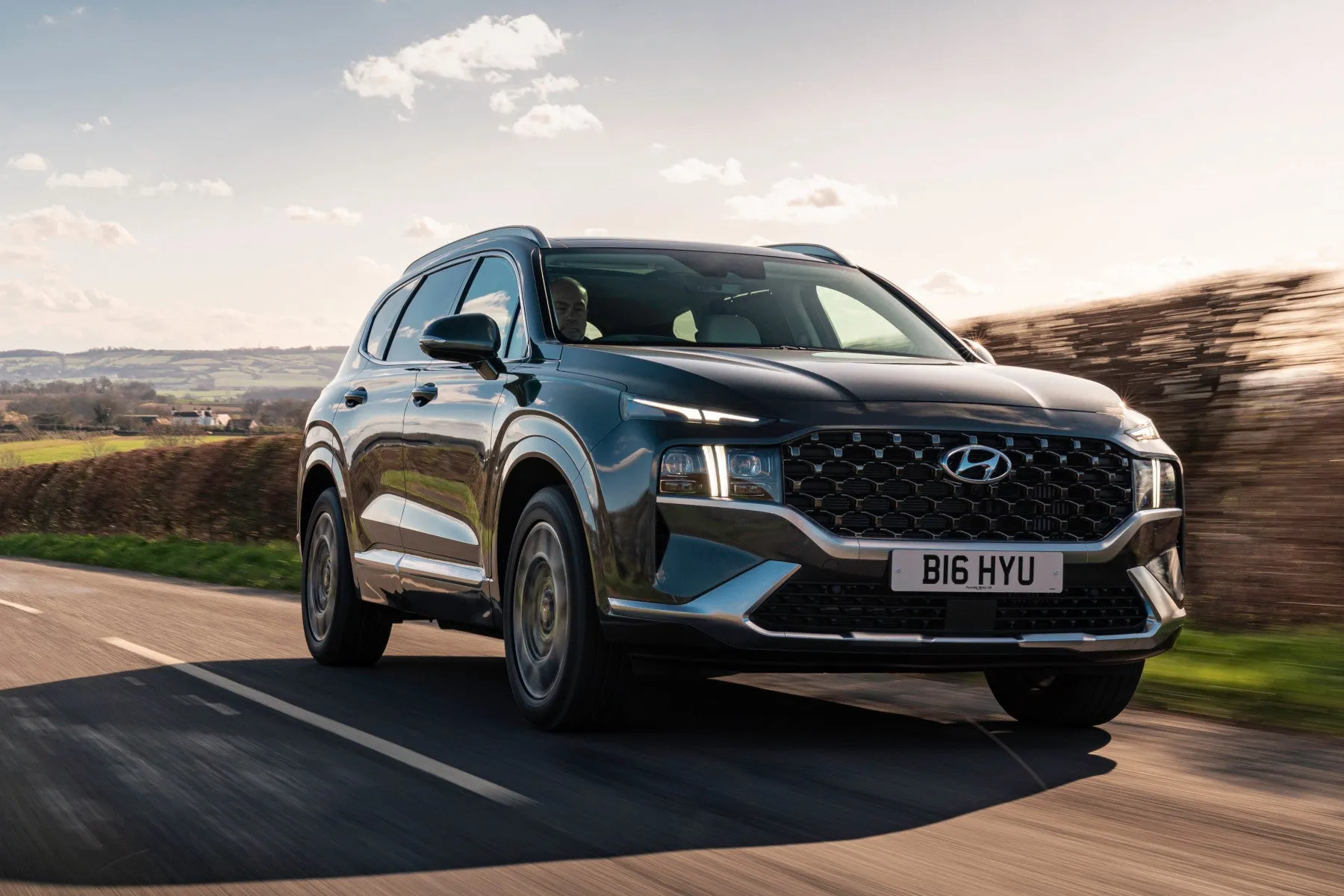
The Hyundai Santa Fe has enjoyed a solid – if unexciting – reputation as a practical family SUV with seven seats that's cheaper than pretty much anything else at a similar size. Now in its fourth generation, the latest Santa Fe has a lot more going for it besides price.
And that's good, because its list price is a lot more in-line with key large SUV rivals than it used to be. Starting at just under £41,500, even the base model is considerably pricier than the cheapest Land Rover Discovery Sport, Peugeot 5008 or Skoda Kodiaq.
That might put you off, but don't click away just yet. The higher list price is reflective of the huge amount of standard equipment you get for your money, while unlike rival models there are no bog basic versions with underpowered engines. Start moving up the range of rivals and, spec-for-spec, the Santa Fe looks like a very competitive seven-seater. And let's not forget the wonders of depreciation making this a much better value used SUV.
Although it shares much under the skin with the Kia Sorento, the Hyundai Santa Fe is an older model now, having been around since 2018. As such Hyundai saw fit to update it in 2021 with a revised design, improved tech and – most importantly – two new hybrid options to join the diesel.
The basics are the same, though - you sit high up, with big comfortable seats providing a Range Rover-like driving position. It’s certainly a car that will happily waft along for hundreds of miles and leave you feeling very relaxed when you arrive at your destination.
There’s space for even very tall adults in the back with generous head and legroom, and all Santa Fe models come with a third row of seats in the boot. These are roomier than most – certainly more accessible and useable for adults than those in the Kodiaq or Discovery Sport – although it still isn't quite as generous as a large MPV. In 2021 the rear seat space was improved slightly, with more legroom in the third row.
The boot is pretty small with all three rows risen, as you'd expect, but the seats can be dropped pretty simply. Even then the boot capacity isn't the largest in the class, but it'll certainly swallow enough luggage for a long weekend away with the kids.
The interior feels relatively premium for an older Hyundai, which helps justify the price – even though the huge mass of buttons on the dash gives its age away a bit. Standard specification is generous, with the top-spec models coming fully loaded: ventilated seats, an opening panoramic sunroof and even remote parking are all chucked in without raiding the options.
Early models came with an eight-inch infotainment system which looks pretty smart and is easy to use, with intuitive menus and quick responses. That was upgraded to a more modern 10.25-inch system in the 2021-on car, with further driver assist and safety tech also added.
While diesel is seen as a dirty word these days, Hyundai only offered one engine in the Santa Fe range until 2021: a 2.2-litre diesel that produces 200PS and 400Nm of torque. Its gutsy low-down power delivery and general smoothness suited the Santa Fe well, but to keep the SUV relevant these days the two new hybrids are probably the best bet.
One is a 'self charging' hybrid and the other is a plug-in hybrid, but both use the same 1.6-litre turbo petrol engine mated to a six-speed automatic gearbox. They aren't quite as good at towing or lugging heavy loads as the diesel, but are much quieter and more efficient around town.
Hyundai’s decided against giving its Santa Fe a sporting edge, which is refreshing when too many rivals demonstrate taut body control and an overly firm ride. It has light steering which is great when tackling city-centre car parks but not so confidence-inspiring on twisty roads, while the suspension is on the floaty side. That’s a good thing, though, as it’ll glide nicely over broken road surfaces without your passengers complaining.
A relatively high price tag means the Hyundai Santa Fe isn’t as popular as it once was, but it still holds plenty of appeal. Look beyond the badge and you’ll find a very capable and comfortable family SUV, while a transferable five-year warranty and reputation for dependability add to its appeal.
Looking for the newer model? You'll need our 2024 Hyundai Santa Fe Review.
Looking for a used car for sale? We've got 100s of Hyundai Approved Used Cars for Sale for you to choose from, including a wide range of Hyundai Santa Fe cars for sale.
Is the Hyundai Santa Fe right for you?
If a diesel suits the kind of driving you plan to do and you need a practical family SUV, the Hyundai Santa Fe is a strong used choice, particularly given its fairly strong depreciation makes it cheaper to buy.
The facelifted model is more relevant to today, though, thanks to its hybrid options. If you need a big, seven-seat SUV – and the smaller third row of seats in something like a Skoda Kodiaq doesn't cut it – the Santa Fe is a good all-rounder.
What other cars are similar to the Hyundai Santa Fe?
There’s some strong competition in the form of the (all very similar) SEAT Tarraco, Skoda Kodiaq and Volkswagen Tiguan Allspace, all of which offer seven seats and a wider engine line-up than the Hyundai Santa Fe. The Hyundai is roomier than all three, however – it's closer in size to a 'full-size' seven-seat SUV like the Toyota Highlander, but has even more space than that for passengers.
The Peugeot 5008 is another very strong contender, as well as the Kia Sorento. You could even compare the Hyundai Santa Fe to premium alternatives like the Land Rover Discovery Sport. There’s the old Nissan X-Trail, too, but the less said about that the better.
Comfort and design: Hyundai Santa Fe interior
"The Hyundai Santa Fe is a big car with loads of interior space for all the family. All models come with seven seats and, while you’d be better looking at a versatile people carrier if you regularly travel seven-up, the rear-most seats are more useful than those found in alternatives like the Skoda Kodiaq."
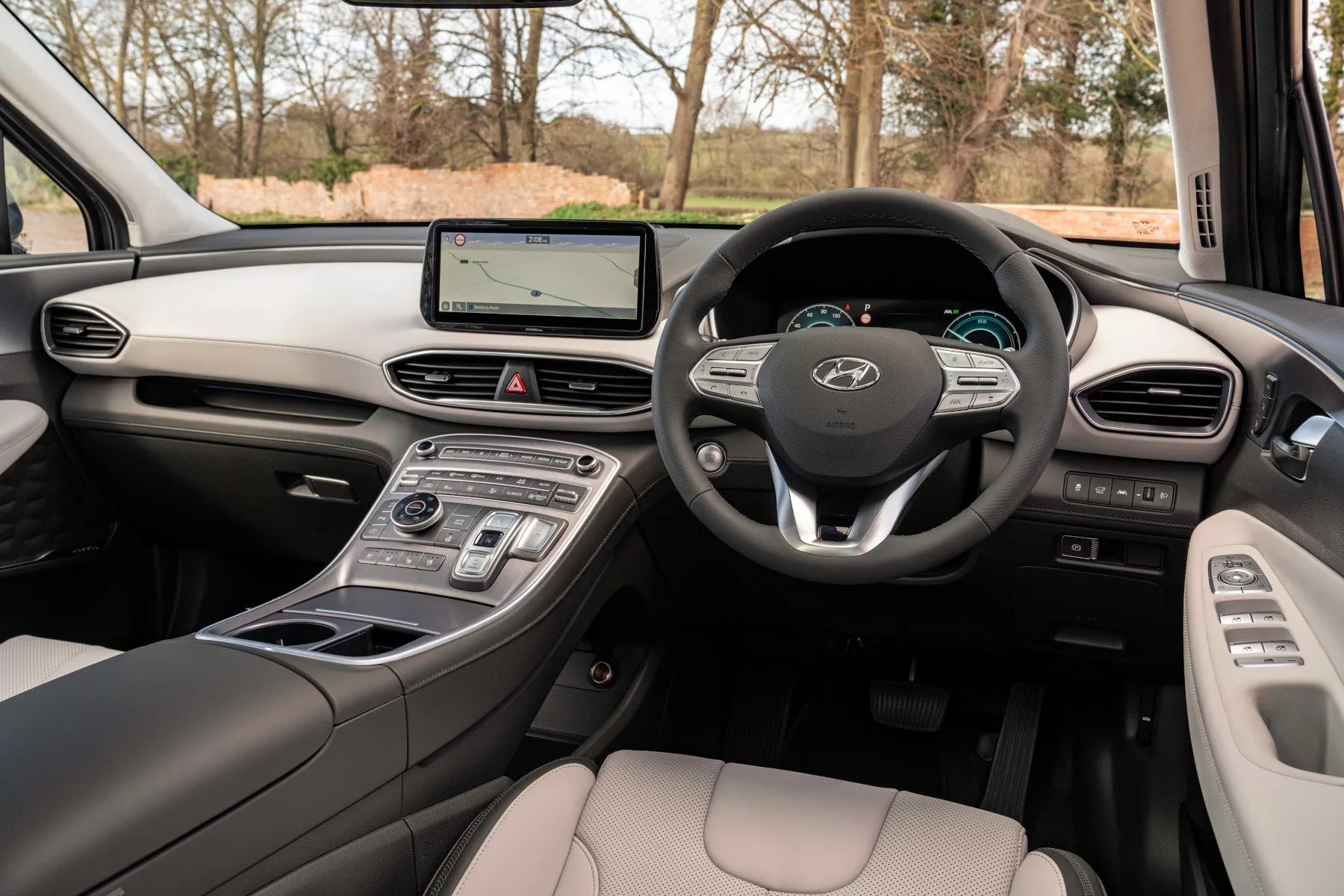
There’s loads of space in the front of the Hyundai Santa Fe, with plenty of useful storage areas and large, comfortable seats providing a good view of the road ahead. It also feels a bit more upmarket inside than the Skoda Kodiaq, although the button-heavy dash design marks it out as one of Hyundai's older models.
The lord-it-over driving position and fairly slim pillars mean very good forward visibility, although seeing out the back is a bit harder where the pillars are chunkier. Happily, every model comes with front and rear parking sensors and a reversing camera. Stump up for Ultimate trim on the facelifted Santa Fe and you'll also get a surround-view camera system to make parking even easier.
Although the multitude of buttons on the dash makes the Hyundai Santa Fe feel like the Starship Enterprise, once you're used to the layout it means things are easier to locate than having to ferret through menus on the touchscreen. What's more, features such as a standard electric AND heated leather front seats make even the base Premium trim feel, well, quite premium.
Early models come with a standard eight-inch navigation system which looks the part and is positioned high up, meaning you can glance at it easily when driving. Part-digital dials were also available. In 2021 both were upgraded with larger screens for both.
Quality and finish
If you'd asked someone a decade or so ago what they thought a Hyundai would be like inside, they would've made a joke about it being as welcoming as a Russian prison. Now the cars have changed quite a lot, perceptions have too.
The Hyundai Santa Fe is chock full of soft-touch trims, chrome-effect switchgear and leather, even on earlier models. Later versions are more classy still, while if you seek out a model fitted with the Luxury pack you'll find two-tone quilted leather upholstery like something out of a Mercedes-Benz.
Granted, it isn't quite that upmarket overall, with some cheaper-feeling plastics to be found lower down. But overall it's a classier place to sit than rivals from Skoda and Toyota.
Infotainment: Touchscreen, USB, nav and stereo in the Hyundai Santa Fe
If you're looking at a used, pre-2021 Hyundai Santa Fe, chances are it will be fitted with an eight-inch touchscreen infotainment system with navigation, plus Android Auto and Apple CarPlay smartphone connectivity.
It's a pretty slick system, mounted within the line of sight but not plonked on top of the dash randomly. The graphics aren't super sharp, but by the standards of the day it's easy to use and responds well to inputs. Entry-level versions were downgraded to seven-inches and navigation was removed, but there wasn't many of those sold - although the screen's interface itself is similar.
After 2021 all versions of the Hyundai Santa Fe were fitted with a bigger, clearer 10.3-inch touchscreen with navigation. You also get wireless phone charging and a Krell sound system with plenty of punch.
The digital dial display options are slightly confusing. If you buy the diesel or Ultimate trim you get a fully digital 12.3 inch display, but all other versions come with a mix of a 4.2-inch screen and analogue dials. Ultimate models also get a head-up display.
Space and practicality: Hyundai Santa Fe boot space
The front of the Hyundai is generously proportioned - even tall or wide drivers will get comfortable thanks to plenty of legroom and a broad cabin.
The same applies in the middle row, where you can recline and slide the seats back and forth to juggle boot space or legroom in the third row with letting those in the middle row stretch out. Ultimate trim brings a panoramic sunroof which eats into headroom a bit, but it's far from tight.
The second row of seats can be folded down (but not folded up) electrically, giving access to a decent third row. Children will be plenty happy back there, particularly as they even get their own air conditioning controls. Adults that aren't too tall will fit as well - there's more head and legroom than in a Skoda Kodiaq or Land Rover Discovery Sport, that's for sure.
With all three rows of seats in place the boot is only useful for a few small shopping bags, but drop the last row and the Hyundai Santa Fe's boot capacity is 571 litres. That's by no means class-leading, but it is big enough and, impressively, there's no sacrifice made by opting for either hybrid model.
The Hyundai Santa Fe's exterior dimensions make it 4785mm long, 1900mm wide and 1710mm tall - considerably larger than a Skoda Kodiaq yet slightly shorter than a Kia Sorento.
Handling and ride quality: What is the Hyundai Santa Fe like to drive?
"Early Hyundai Santa Fes are diesel-only. In order to broaden its appeal Hyundai added two hybrid versions in 2021, however."
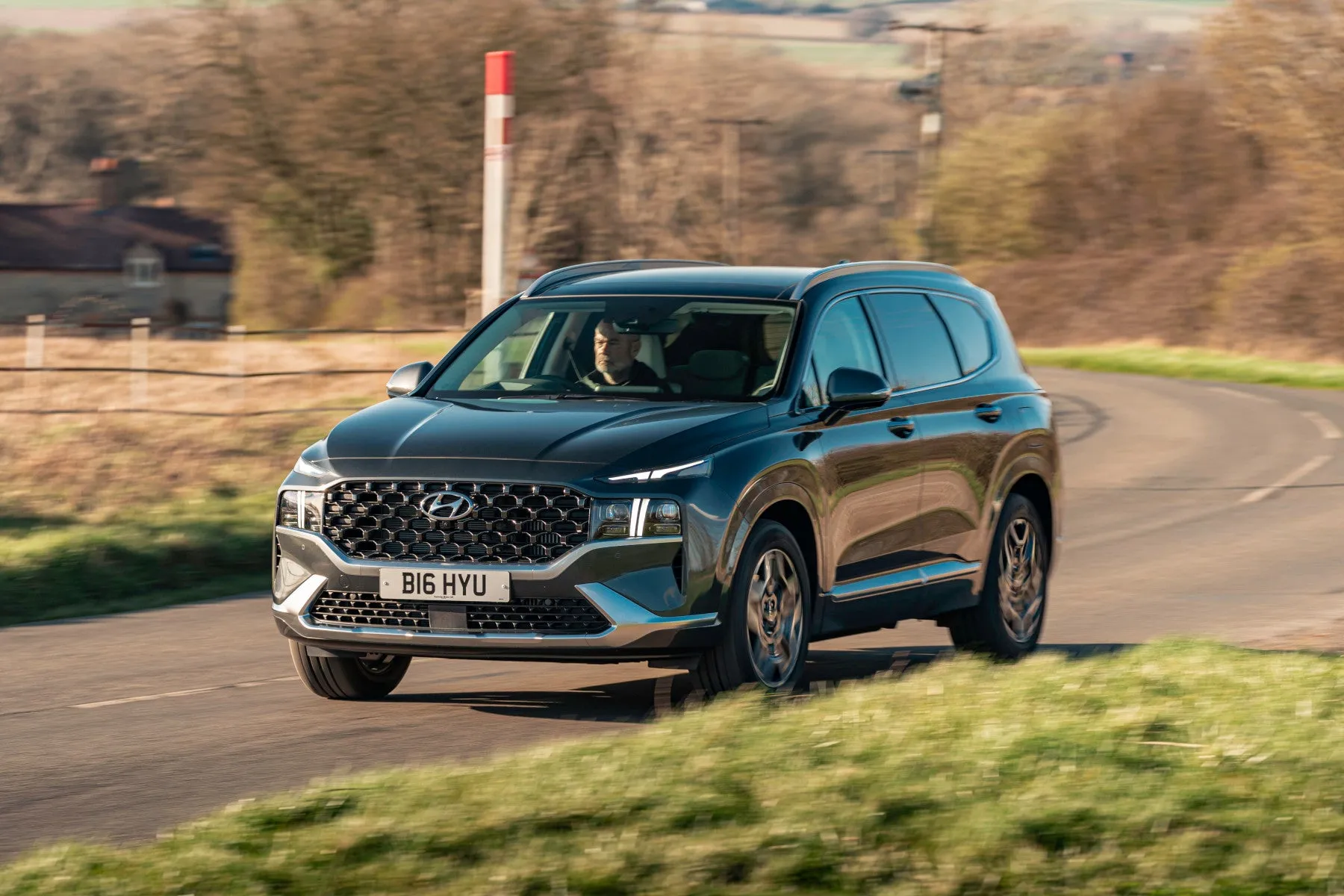
The Hyundai Santa Fe's driving experience majors on making smooth and unruffled progress over being super sharp in the bends. Which makes sense. Why you'd want to fling a large family SUV down a twisty road at full pelt is beyond us...
The Santa Fe does lean about a bit in hard cornering and feels less agile than, say, a Skoda Kodiaq. But the trade-off is a smooth, soft ride that keeps potholes and speed bumps from shuddering your passengers. And that's what you'd want in something like this, right?
You’ll feel the Hyundai Santa Fe’s dimensions in town centres, although visibility is good and there’s plenty of tech on offer to make your life easier, including the standard sensors and reversing camera. A high seating position contributes to a feeling of solidity and safety at motorway speeds, and although refinement is generally decent there's more wind noise than there is in some rivals.
The plug-in hybrid Hyundai Santa Fe adds around 200kg to the car's overall weight compared with the diesel. In reality, though, we reckon you'd be hard-pushed to notice the difference unless your family holiday involves a lap of the Nurburgring.
What engines and gearboxes are available in the Hyundai Santa Fe?
If you're opting for a used Hyundai Santa Fe over about a year old, chances are it'll be powered by the 2.2-litre diesel engine. That was the only engine option available prior to the facelift.
Fortunately, it’s a pretty good one. With 200PS and 440Nm of torque on tap it makes for a strong tow car, and is quick enough for day-to-day driving, while avoiding being too noisy. You can opt for a six-speed manual or eight-speed automatic transmission, while both come with four-wheel drive. It’s not going to keep up with a Land Rover Discovery Sport off-road, but its four-wheel-drive system should give you extra confidence in wintery conditions.
Chances are that, if you're buying new, you'll want one of the newer hybrid models instead. In 2021 Hyundai added two - the HEV (that's a regular, self-charging hybrid to you and me) and the PHEV (the plug-in hybrid).
Both Hyundai Santa Fe hybrids use a 1.6-litre turbo petrol engine and six-speed automatic gearbox as their base. the HEV adds to that a small battery and 60PS electric motor. Front-wheel drive or four-wheel drive versions are available, both with an output of 230PS.
Performance is decent, while it's smoother around town than the diesel and able to run in electric-only mode for short distances. Its performance is just about adequate in the heavy Santa Fe, however, with a 0-62mph time of 8.9 seconds. Overtaking is doable, but the diesel's low-end grunt makes it more effortless.
We've not yet driven the Santa Fe plug-in hybrid. It's four-wheel drive only, and the combined output raises to 265PS, but because of the heavier 12.8kWh battery performance is about the same. Officially it'll do up to 36 miles on a charge.
Refinement and noise levels
The diesel Hyundai Santa Fe is a bit grumbly at low speeds, but smooths out pretty well once you're cruising along. It's not the one to go for if ultimate refinement matters, however.
The hybrids are a better bet for that, in particular the plug-in hybrid that has meaningful electric range and will cruise around in near-silence. The self-charging hybrid is quite difficult to keep in electric-only mode (you'll need to treat the throttle like it's made of glass), meaning it's less tranquil.
The petrol engine in the hybrids is smooth enough when you're pottering about, but ask for full performance to get up to speed on a slip road and it gets a bit noisy. Road noise is kept at bay pretty well, but you might notice a bit more wind noise than in the Kia Sorento.
Safety equipment: How safe is the Hyundai Santa Fe?
Even early Hyundai Santa Fes come fitted as standard with automatic emergency braking, while adaptive cruise control was standard on all automatics. You'll get blind spot monitoring on Premium and Premium SE trims.
In 2021 Hyundai added its clever and useful blind spot camera system to the Santa Fe. This uses cameras on the door mirrors to project a live video feed of each blind spot onto the instrument display - it's not as distracting as you might think, and works really well.
In 2018 Euro NCAP awarded the Hyundai Santa Fe a full five-star safety rating in its crash tests.
MPG and fuel costs: What does a Hyundai Santa Fe cost to run?
"The Hyundai Santa Fe is quite a big car but, with only diesel and hybrid engines to choose from, it won't break the bank in terms of running costs."
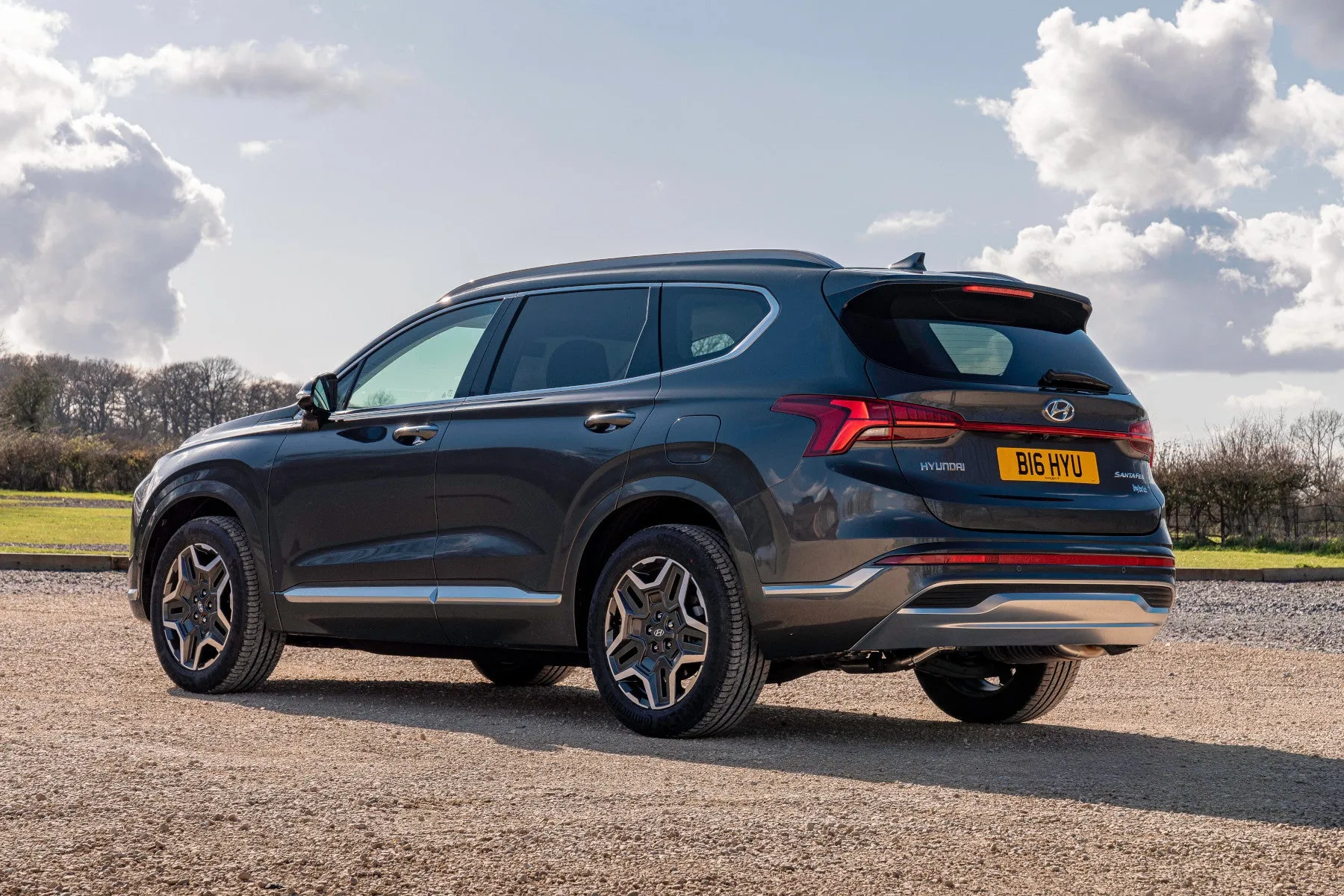
Officially, the diesel Hyundai Santa Fe returns up to 42.8mpg in WLTP fuel economy tests, dropping to 41.5mpg with the automatic gearbox. That's a decent (but not amazing) figure and should be achievable unless you're just running around town, while a 71-litre tank means a good range between fills.
However, hybrids are where the money is in 2022, and it's good to know that the self-charging hybrid (which is basically just a petrol model with a bit of electric assistance) still puts a good showing in here. It'll do 44.1mpg combined in 2WD form, with that dropping to 40.4mpg with four-wheel drive.
The plug-in hybrid model promises an impressive 173mpg combined, but as is always the case with plug-in hybrids this figure is simply for comparison. If you only potter about under electric power and regularly charge at home it may well be possible, but on a long run with a depleted battery expect 35-40mpg.
How reliable is the Hyundai Santa Fe?
Hyundai finished an impressive third place out of all the brands in the latest HonestJohn.co.uk Satisfaction Index. Clearly the Korean company is doing something right, and offering a five-year, unlimited mileage warranty as standard shows confidence in their own engineering.
There's a lot of technology and equipment in the Santa Fe, but we've not heard of any serious issues, so it should prove reliable family transport.
Insurance groups and costs
The Hyundai Santa Fe is cheapest to insure as a two-wheel drive hybrid, where it is in group 22. Steeping up to the diesel increases that group to 26, while the plug-in hybrid is slightly more expensive to insure.
VED car tax: What is the annual road tax on a Hyundai Santa Fe?
One costly expense that’s worth bearing in mind is road tax (VED). For 2022 models this will cost a flat rate of £165 a year after the first year, plus a premium of £355 a year for five years (from the second time the car’s taxed) for cars with a list price of more than £40,000. That’s every Hyundai Santa Fe you can buy new.
The hybrid models will give you a saving of £10 on the annual VED rate, but that's hardly going to make you jump up and down for joy. A new diesel will set you back an eye-watering £945 for the first year rate, while opting for the four-wheel drive version of the hybrid model adds a full £355 extra for the first year over the two-wheel drive model. At least the plug-in hybrid is only £10 to tax in the first year.
How much should you be paying for a used Hyundai Santa Fe?
"Early Hyundai Santa Fe models are less generously equipped unless you opt for the Premium variants. After 2021, the cheapest model is still loaded up with kit. "
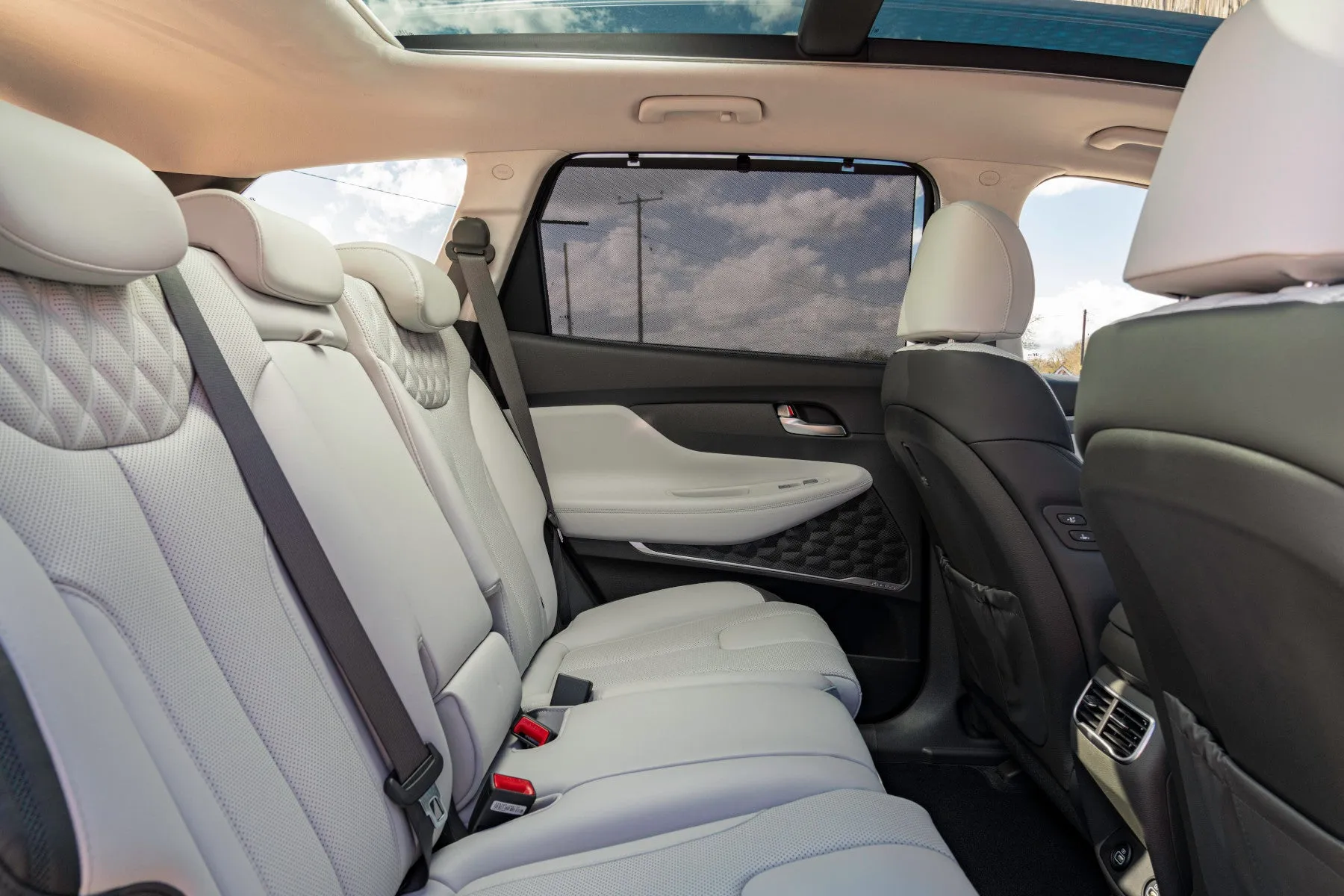
Used prices for this generation of Hyundai Santa Fe start at around £25,000 for a diesel model in entry-level form. £28,000 is enough for a four-wheel drive version in Premium form.
When buying new, the cheapest Hyundai Santa Fe - the two-wheel drive hybrid Premium - is £41,445. The now four-wheel drive-only diesel adds around £800 to that, while the four-wheel drive hybrid is £1600 more.
You'll need another £3200 on top of the 4WD hybrid for the plug-in hybrid Santa Fe. Ultimate trim is £3300 more expensive than the equivalent Premium model.
Trim levels and standard equipment
If you're buying a used Hyundai Santa Fe seek out a mid-range Premium or high-end Premium SE model, because these come more generously equipped. SE models do without sat-nav, leather, LED headlights and an electric tailgate.
If you're buying a 2021-on model the entry-level trim has been ditched, with Premium or Ultimate trims on offer.
The Hyundai Santa Fe Premium is equipped with 17, 18 or 19-inch wheels depending on the engine, heated leather seats with rear outer seat heating, front electric seats, a heated steering wheel, dual-zone climate control, full LED headlights adaptive cruise control with low-speed operation, a reversing camera, front and rear parking sensors, self-levelling rear suspension, sat-nav and an electric tailgate.
Stepping up to the Hyundai Santa Fe Ultimate changes the wheel size options to 19 or 20-inches, plus adds the blind spot camera system, Highway Driving Assist, parking collision avoidance, rear-cross traffic alert, a surround-view camera, remote smart parking assist, a panoramic sunroof, rear door blinds, ventilated front seats and a memory function for the driver's seat.
Ask the heycar experts: common questions
Is the Hyundai Santa Fe or the Tucson bigger?
Is the Hyundai Santa Fe worth it?
Which SUV is comparable to the Hyundai Santa Fe?
Get our latest advice, news and offers
Keep me updated by email with the latest advice, news and offers from heycar.
By submitting you agree to our privacy policy



